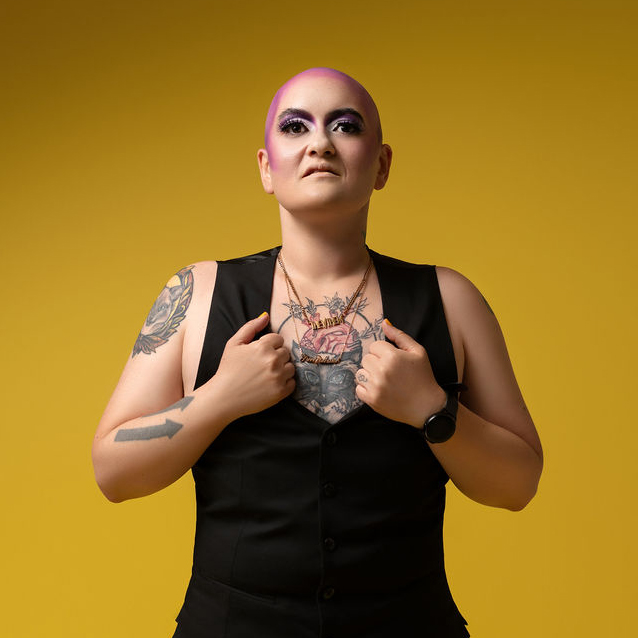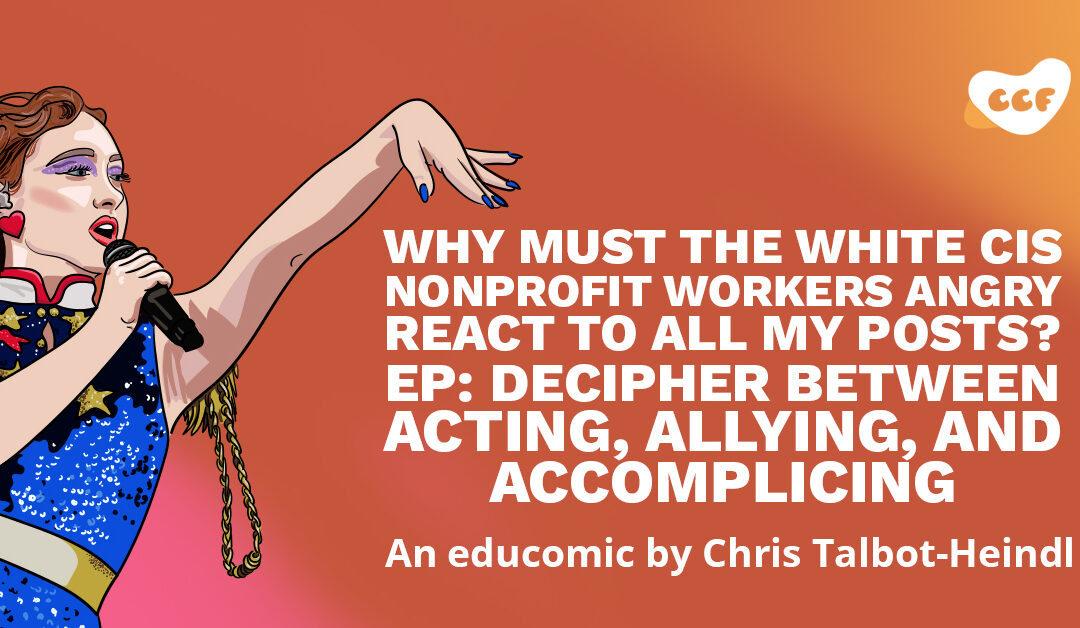By Chris Talbot, communications professional and educomics creator
Go back to the infographic via this link
Introduction
There’s an illustration of Chappell Roan performing in a red, white, blue, and gold outfit. Text says “White women, we need to talk. Specifically about Chappell Roan. Before y’all get big mad, I have to say that I am a fan. (I have to be. I’m a queer. It’s required.) I’m also a fan of how outspoken she’s been for Palestinian liberation. But… and it’s a big one… y’all praised her for the recent interview in Rolling Stone claiming that she’s an amazing ally for rejecting the offer to play at the White House. And worse, you came after BIPOC DEI specialists and liberation activists who took issue with this. This specific action was not the action of an ally or accomplice. This was the action of an actor and shouldn’t be the type of action you aim for.”
First Section
There’s an illustration of Parker McMullen Bushman — a Black nonbinary woman — wearing a yellow skirt suit with a headwrap. Text says “To help me illustrate this point, I want to bring in a framework taught by my brilliant bestie, Parker McMullen Bushman (aka: KWEENWERK of EcoInclusive Strategies):”
There’s a table with three columns. The first column is labeled “Actor.” There’s a list of characteristics that says “Actions are performative and don’t challenge the status quo. Typically for gain — ex. social capital.” Below that, it says “Ex: Black squares on social media, safety pins on lapel (when you don’t do anything in the moment), or telling Rolling Stone you turned down an opportunity at the White House because of a genocide months later.” The second column is labeled “Ally.” The list of characteristics say “Actions operate in solidarity with marginalized folks. Actions operate in privileged spaces and challenge the status quo by educating themselves and others.” Below that, it says “Ex: Using your social media to post about the genocide and educational resources to inform your friends and family who think it’s ‘too complicated’ to get involved or publicly stating why you turned down an opportunity to play at the White House.” The third column is labeled “Accomplice.” The list of characteristics says “Actions are coordinated with Black, Brown, Indigenous, and other POC liberation movements to disrupt the status quo and challenge systems of oppression.” Below that, it says “Ex: Disrupting the harm happening to BIPOC colleagues and strangers who are being punished, fired, defunded, and otherwise targeted for their activism, accepting an invitation to play at the White House and reading Palestinian poetry there.
There’s an illustration of a black box, a proud ally button, and a safety pin. Text says “Being an accomplice means actively risking something (social capital, physical safety, time, resources) and fighting alongside folks from marginalized identities for your collective liberation. You can wear the proud ally pin or safety pin, but only if you’re prepared to disrupt when things go down. It’s not a symbol in and of itself, it’s a symbol that when people need you, you are committed to be there.”
Second Section
There’s an illustration of President Lyndon B. Johnson towering over and looking at Eartha Kitt. Text says “The first step of this is to determine what you are willing to risk while being honest with yourself about what your risk is. Don’t let your lizard brain take over. Chappell Roan’s publicist did her a disservice by suggesting there would be a cost there would likely not be. Chappell isn’t Eartha Kitt and it isn’t the 1960’s.
“There’s a common mistake that white people make when assessing risk, which is to take on the risk assessment of people with multiply marginalized identities. White queer folks take on the risk assessment for BIPOC trans queer people all the time. White women take on the risk assessment of black women all the time. They say things like “Look what happens to a woman who speaks up!” when the reality is that the intersection of blackness has changed the assessment astronomically.
The next step is determining what you are willing to risk based on your accurate risk assessment.
There’s a checkmark list of possible risks. The first is checked, which is “Loss of some fans.” The second is “Loss of some future invites.” This one is crossed out with the text “Not willing to lose the White House” written beneath it. The third is “Loss of some future gigs.” This one is crossed out with the text “Not willing to lose the White House.” The fourth is “An Eartha Kitt situation.” This one is crossed out with the text “Unlikely since Chappell isn’t Black.” The fifth is “Israel’s ire.” This one is crossed out with the text “Unlikely since Chappell is white.”
Text says “The final step is being honest about that and not taking actor points by announcing what you would have done if your allyship or accompliceship was deeper than it is.
(Disclaimer: Chappell Roan has not said that this was an act of allyship or accompliceship. It is likely she knows this was performative and didn’t expect it to garner the attention it has. This educomic is not to take away from her actual ally and accomplice work or imply she doesn’t know the difference. It is her fan base that has attributed a level of allyship that doesn’t exist in this case. This is for their edification. Aka: Don’t sue me. LOL.)

Chris Talbot
Chris Talbot (they/them) is a queer, trans nonbinary, mixed-race artist, activist, and nonprofit employee. When they aren’t working the day job, they spend their free time editing art and literature magazines, writing and illustrating educomics to help folks affirm their nonbinary pals, creating a graphic novel to describe what it’s like to be nonbinary in a gender binary world, cuddling their cat, and quad skating in the park.
You can find Chris at talbot-heindl.com, on LinkedIn, Instagram, Bluesky, and Twitter — and tip them on Venmo or PayPal or join as a patron on their Patreon
Photo credits: Makeup by Brittany Blaze-Shearz; Direction and photograph by Chermetra Keys/The Female Shoota; cattoo by Aura Rain Heindl-Rockman.
Discover more from CCF
Subscribe to get the latest posts sent to your email.

